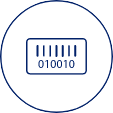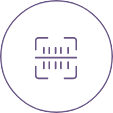How asset tracking can be used
There are many uses for asset tracking. We won’t go into detail on all of them, but here are a few that can get you started thinking about how you can use barcode scanners and/or RFID (short for radio frequency identification) readers in your business:
- Tracking high value assets that tend to get lost, misplaced or stolen
- Tracking assets that get put together but whose components aren’t stored together
- Keeping assets that should NEVER go together well apart from each other (e.g., hazardous materials)
- Ensuring assets that are sensitive to environmental conditions remain safe
- Shipping notifications when items pass a particular point
- Tracking down assets when a defect is identified, or a recall is issued
RFID reader vs. barcode scanner technology: basic differences
RFID reader and optical barcode scanner technologies can both help a company improve productivity, performance, compliance, safety and security through asset tracking. Here are some of the basic differences between the two technologies.
Barcode scanner
- Scan labels individually
- Printed on paper or adhesive
- Scanner requires direct line of sight to label
- Stores a limited amount of information
- Data is not encrypted
- Read-only functionality
- Generally less expensive than RFID
- Barcodes can be easily copied
- Technology standardized worldwide
RFID reader
- Scan multiple tags at once
- Printed using sturdy, reusable materials
- Can be read at a distance or through objects
- Can store complex information
- Data can be encrypted for security purposes
- Read and write (encoding) functionality
- Generally more expensive than barcode
- Can be complex to install/integrate
Labels are used for one-to-one tracking—you physically scan one label, and you know you’ve only scanned one label. With RFID tags, you’re able to scan many items in seconds (a whole pallet in 30 seconds or so in many cases). In short, barcode is best when you want one-to-one accuracy, and RFID is better for inventory applications.
Choosing the right barcode scanner or RFID reader technology for your application
Optical barcode scanner and RFID reader technologies can both help a company improve productivity, performance, compliance, safety and security through asset tracking, but there are distinct differences that require consideration before choosing one or the other. Among the considerations:
- The technology you already have in use
- The material or asset the label/tag will be affixed or attached to
- The physical environment the asset will be exposed to
- How the asset will be handled and how long it will be used
- How much/what type of information needs to be embedded in the tag itself
- Whether there are industry regulations you must comply with
Types of labels and tags used with barcode scanners and RFID readers
There are hundreds of different types of labels and tags that can be used with barcode scanners and RFID readers, each with its own advantages and limitations. Choosing the right one for the application at hand depends on several factors, including:
- Material composition – the type of material the label or tag is being affixed to
- Surface shape – the shape of the asset, e.g., curved, flat, pebbled, smooth, etc.
- Environmental conditions – some must be able to withstand harsh conditions such as chemicals, high temperatures and abrasion
- Handling – how the asset will be handled as it is moved from place to place
- Compliance standards – some regulatory bodies dictate what type of information is required
- Information required – some assets just need an identifier and price, while others require more information
- Printing equipment – the type of label maker being used for printing labels or tags
As an example, here are three very different use cases that would require completely different approaches to each factor identified above:
| |
Edible Produce |
Circuit Board |
Caustic Material |
| Material |
Food |
Epoxy Resin |
Non-corrosive barrel |
| Shape |
Uneven |
Flat |
Curved |
| Environment |
Temperature-controlled |
Heat-producing, solvents |
Outdoors |
| Handling |
Picked up individually |
During manufacturing/repair |
Cautiously moved/stored |
| Compliance |
None |
MIL-STD-202G |
Hazmat |
| Information |
Type, price, lot |
Model number, manufacturer |
Safe handling, compliance info |
| Printing |
Handheld portable printer |
Industrial THT label printer |
Industrial THT label printer or Industrial InkJet for barrell labels |
| Label/tag characteristics |
Food-grade adhesive, easy to remove, flexible |
Abrasion-Resistant, Chemical-Resistant, Corrosion-Resistant, Humidity Resistant, UV-Resistant |
Harsh environment, OSHA regulations, permanent |
Types of barcode scanners and RFID readers

There are also many different kinds of optical barcode scanners and RFID readers, most of which fall into the categories of handheld or fixed (like those that you find in retail self-checkout kiosks). Optical barcode scanners use a beam of light to “read” the barcode printed on a label or tag. RFID readers pull data from RFID chips embedded in them via radio waves. Obviously, which type you choose depends on whether you’re using barcode or RFID technology, but there are other considerations as well, including:
- Read range – how far away the asset will be from the reader or scanner
- Read speed – how many assets will be scanned/read and how quick
- Location density – how many assets will be within “reading” distance and how close together they will be
- Label/tag location – affixed or attached inside or outside of an asset, wrapped around something, etc.
- Asset orientation – pertaining to how the asset will be moved and/or stored
- Barcode type – 1 dimension (1D) flat barcode, 2D QR code, 3D barcode
| |
Grocery Store Checkout |
Storage Warehouse |
Manufacturing Line |
| Read Range |
Centimeters |
Feet |
Varies |
| Read speed |
One at a time, fairly slow |
Slow |
Fast |
| Location density |
Single |
Tightly packed, lots and singles |
Close |
| Label/tag location |
Affixed exterior |
Varies |
Varies |
| Asset orientation |
Turned to face reader/scanner |
Stored to face reader/scanner |
Varies |
| Barcode Type |
1D |
1D and 2D |
1D, 2D, DPM |
| Possible solution |
Low Cost Optics packages integrated into check-out kiosks. Rolling shutter. |
Mobile handheld scanner. Either dedicated device tethered to mobile computer, or mobile device (e.g. phone / tablet). Rolling Shutter. |
Industrial ruggedized handheld and fixed readers. Rolling and Global Shutter for high-speed applications. |
The software
The barcode scanner or RFID reader sends information back to a database, and from there the choice of software dictates what happens. It varies by application. For instance, the software may send a message if an asset is in an area it’s not supposed to be in, automatically update the location within the database, then prompt a user to take an action. At the other end of the spectrum, software can dictate how your data is reported so you can use it to make relevant business decisions.



